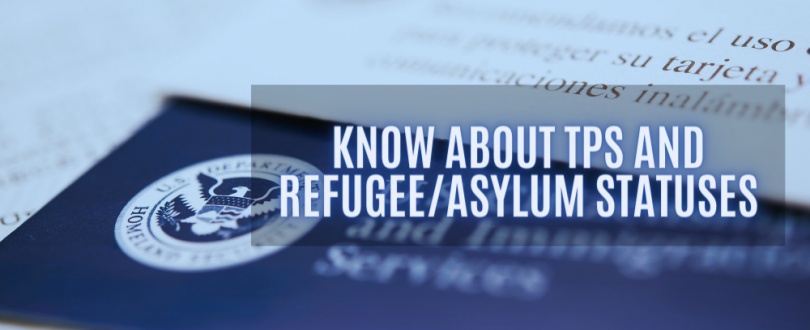
Understanding immigration statuses can be complex, especially for travelers who might encounter different terms and regulations during their journeys. In this blog post, we’ll delve into Temporary Protected Status (TPS) and Refugee/Asylum, shedding light on what they mean, how they differ, and how they impact individuals and travelers alike.
What is Temporary Protected Status (TPS)?
Temporary Protected Status (TPS) is a humanitarian designation by the U.S. government, allowing nationals of certain countries experiencing extraordinary conditions to live and work in the U.S. temporarily. These conditions may include ongoing armed conflict, environmental disasters, or other unsafe situations.
Countries Currently Designated for TPS
Countries designated for TPS change over time based on current conditions. As of now, countries like El Salvador, Haiti, Honduras, Nepal, Nicaragua, Somalia, Sudan, South Sudan, Syria, Venezuela, and Yemen have TPS designations. Travelers should check the latest updates from U.S. Citizenship and Immigration Services (USCIS) for current designations.
Eligibility Criteria for TPS
To qualify for TPS, an individual must:
– Be a national of a country designated for TPS or a person without nationality who last habitually resided in such a country.
– Have been continuously physically present in the U.S. since the effective date of the most recent designation.
– Meet other eligibility requirements, including those related to criminal history and security.
Benefits and Limitations of TPS
TPS provides:
– Protection from deportation.
Authorization to work in the U.S.
– However, TPS does not lead to permanent residency or citizenship. Beneficiaries must periodically re-register and can still face removal if TPS is withdrawn from their country.
Application Process for TPS
The process involves:
– Submitting Form I-821, Application for Temporary Protected Status.
– Providing evidence of identity, nationality, and continuous residence in the U.S.
Paying the required fees and attending a biometrics appointment if applicable.
– Travelers should ensure all documentation is accurate and complete to avoid delays or denials.
Understanding Refugee Status
A refugee is someone forced to flee their home country due to persecution based on race, religion, nationality, membership in a particular social group, or political opinion. Refugees typically apply for protection from outside the U.S.
Criteria for Refugee Status
Refugee status is determined by international laws and conventions, including the 1951 Refugee Convention and the 1967 Protocol. To qualify, an individual must:
– Be outside their home country.
– Have a well-founded fear of persecution based on specific grounds.
Application Process for Refugee Status
To apply for refugee status:
– Register with the United Nations High Commissioner for Refugees (UNHCR) or a U.S. embassy.
– Undergo extensive interviews and security screenings.
– Wait for a decision, which can take months or even years.
Rights and Benefits for Refugees
Refugees are granted legal status to live and work in the U.S., with access to social services, healthcare, and education. They can apply for permanent residency after one year.

Understanding Asylum Status
Asylum status is granted to individuals already in the U.S. or at its borders who meet the definition of a refugee. Asylum can be sought affirmatively by someone already in the U.S. or defensively by someone in removal proceedings.
Criteria for Asylum Status
To qualify for asylum, an individual must demonstrate:
– A well-founded fear of persecution based on race, religion, nationality, membership in a particular social group, or political opinion.
Application Process for Asylum
The steps include:
1. Filing Form I-589, Application for Asylum and Withholding of Removal.
2. Providing detailed personal statements and supporting evidence.
3. Attending an interview with a USCIS asylum officer or an immigration court hearing.
Rights and Benefits for Asylum Seekers
Asylum seekers granted asylum can live and work in the U.S. and can apply for permanent residency after one year and eventually for citizenship.
Comparing TPS, Refugee, and Asylum Statuses
While TPS, refugee, and asylum statuses all protect from deportation and the right to work in the U.S., they differ significantly:
– TPS is temporary and country-specific, providing relief during crises but not a path to permanent residency.
– Refugee Status is granted to those outside the U.S. seeking protection from persecution, offering a path to permanent residency and citizenship.
– Asylum Status is for those already in the U.S. or at its borders seeking similar protection and also offers a path to permanent residency and citizenship.
Real-Life Examples
Consider the case of a Syrian national who fled due to the civil war. They might apply for refugee status from a neighboring country or seek asylum upon reaching the U.S. Alternatively, a Honduran national already in the U.S. might apply for TPS if conditions in Honduras worsen.
Current Issues and Challenges
Immigration policies are subject to change, impacting TPS designations and asylum laws. Applicants face legal hurdles, social integration challenges, and economic difficulties. However, support is available from government agencies, NGOs, and community networks.
Recent Developments
Stay updated with the latest changes in TPS designations and asylum procedures by regularly checking official government websites and reputable news sources.

